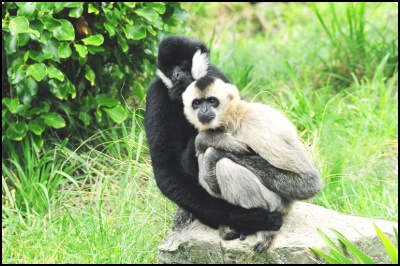Wellington Zoo leading the way to save White Cheeked Gibbons
Wellington Zoo leading the way to save critically endangered White-Cheeked Gibbons in the wild
Wellington Zoo is helping to save critically endangered White-Cheeked Gibbons in the wild by taking a pivotal role in a new partnership with the Fauna and Flora International Vietnam Programme.

Vilson and Robyn, Northern White-Cheeked Gibbons at Wellington Zoo.
The new venture is a targeted project to improve conservation of White Cheeked Gibbons through improved protection of key areas in Pu Mat National Park. With about 455 individual animals, this area is home to the only known viable population of these Gibbons left in the world.
“We’re excited to be igniting conservation action as a founding partner in this new project to save White-Cheeked Gibbons in the wild,” says Daniela Biaggio, Conservation Manager at Wellington Zoo. “The morning chorus of our two gibbons, Robyn and Vilson, is an iconic feature at Wellington Zoo, and it will now be a cheer for the efforts we are making to save their species in the wild.”
The number of White-Cheeked Gibbons in the wild has reduced more than 80% over the last 45 years, primarily due to hunting and habitat loss. They are functionally extinct in China, while populations in Vietnam and Lao PDR are severely depleted. Without effective conservation efforts, it is likely that most Vietnamese populations will be lost in the near future.
“Now more than ever, conservation organisations need to work together to save animals in the wild,” says Daniela. “By collaborating with Perth Zoo and Taronga Zoo as the main funding consortium for this targeted project, our collective efforts will make a difference for the animals and the community surrounding Pu Mat National Park. The area is a hotspot of biodiversity, so protecting the park will save not only Gibbons, but also other endangered animals like Indochinese Tigers and Indian Elephants.”
Led by Dr. Ben Rawson, Vietnam Country Director at Flora and Fauna International, the project will focus on reducing hunting by working with the government, park rangers, and the local community to help enforce protection of the forest.
The cornerstone of the project is the establishment of a smart patrol system - a bottom-up approach that aims to equip park rangers and managers with information technology to better protect areas, boost their morale, and be proud of their duty. The team will provide technical support to use SMART, an open-source software developed by the conservation community which provides advanced analysis and reporting of patrol data and intelligence to better plan enforcement activities to protect wild animals.
“Engaging local communities living in the ‘buffer zone’ of the protected area with forest protection activities like forest patrols and snare removals will create job opportunities, which will also be supported through environmental education in key villages,” says Daniela. “We’ve committed to a long-term investment to make sure that the numbers of wild Northern White-Cheeked Gibbons can increase and be brought back from brink of extinction so that the Gibbons’ song can be heard in the wild for generations to come.”
More information
All 25 of the
world’s gibbon species and sub-species are threatened with
extinction. The Northern White-Cheeked Gibbon is Critically
Endangered.
The project aims to improve conservation of White Cheeked Gibbons through improved enforcement and protection of key areas in Pu Mat NP. It will assess enforcement performance of the park and provide technical support to implement SMART enforcement approaches, allowing for adaptive management.
To learn more about SMART, visit www.smartconservationtools.org
ENDS


 Commerce Commission: ComCom Warns Of Pyramid Schemes After South Auckland Scammers Plead Guilty
Commerce Commission: ComCom Warns Of Pyramid Schemes After South Auckland Scammers Plead Guilty MBIE: MBIE Publish Mid-Point Review Of The Phase-Out Of The Low Fixed Charge (LFC)
MBIE: MBIE Publish Mid-Point Review Of The Phase-Out Of The Low Fixed Charge (LFC) Science Media Centre: Company Claims To Have “De-Extincted” The Dire Wolf – Expert Reaction
Science Media Centre: Company Claims To Have “De-Extincted” The Dire Wolf – Expert Reaction Stats NZ: Greenhouse Gas Emissions Fall 2.0 Percent In The December 2024 Quarter
Stats NZ: Greenhouse Gas Emissions Fall 2.0 Percent In The December 2024 Quarter The Reserve Bank of New Zealand: Christian Hawkesby Appointed As Governor Of The RBNZ
The Reserve Bank of New Zealand: Christian Hawkesby Appointed As Governor Of The RBNZ Kiwi Economics: It’s Mayhem In Markets As Downside Risks Dominate Following Trump’s Tariffs
Kiwi Economics: It’s Mayhem In Markets As Downside Risks Dominate Following Trump’s Tariffs



